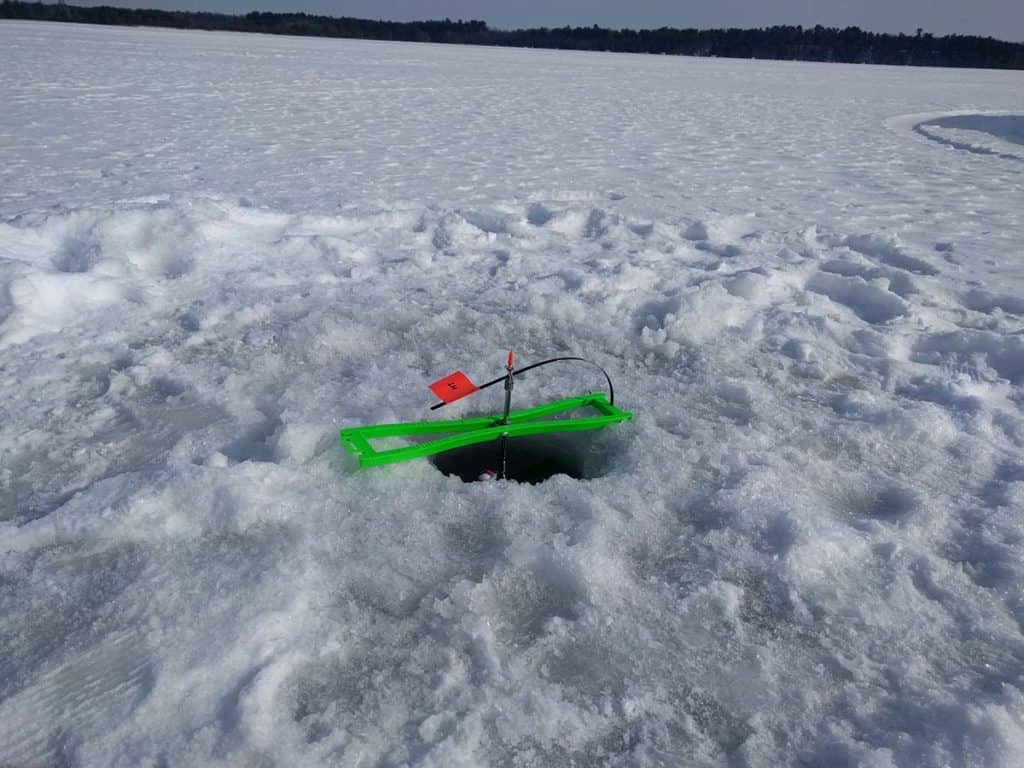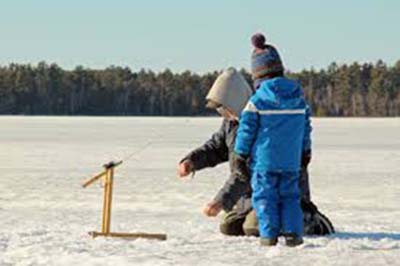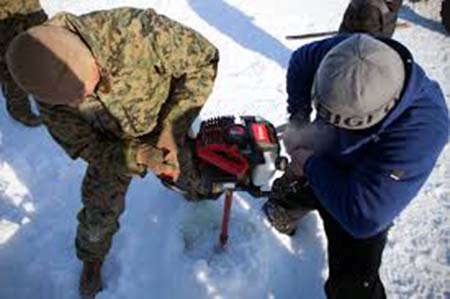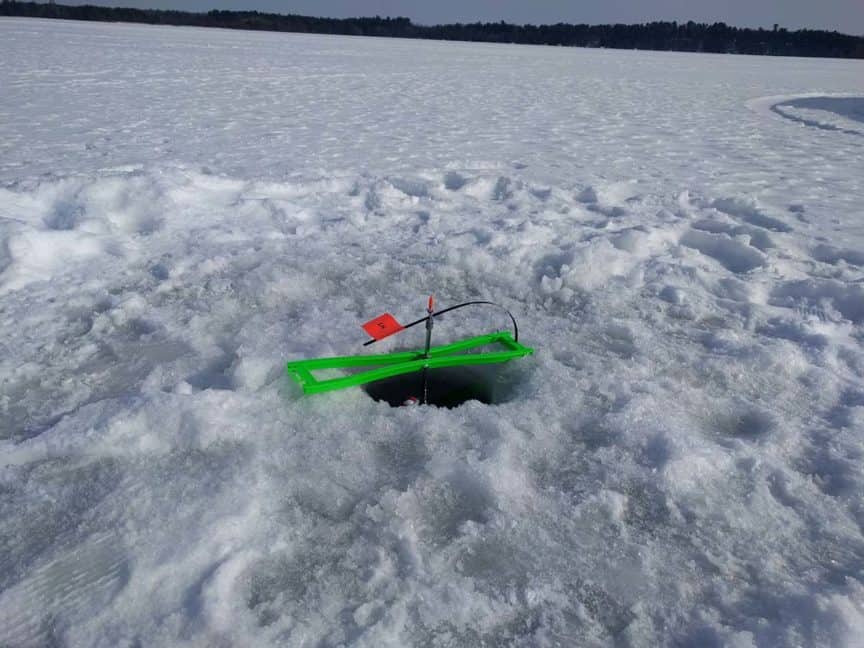Some outdoor enthusiasts find ice fishing a great pastime during the cold months of winter. Without following the right ice fishing tips and techniques, your days are going to be hard and long with almost no success. The sport has changed over the years thanks to the invention of powerful types of equipment that make drilling holes less tasking.

Ice Fishing Tips And Techniques
With augers that are two or three times more powerful, fishers no longer need to drill single holes and hope fish will appear. They can make as many holes as long as they are within the designated fishing areas.
Ice fishing is slightly different from warm-weather fishing. With the cold weather and low oxygen levels affecting fish behavior, the fishing techniques applied during the summer season may not be successful during winter. The text explains ideal techniques for ice fishing and tips to help you catch more fish with assurance.
Topics Covered In Ice Fishing Tips And Techniques
- When to catch fish
- Where to catch fish
- Making a hole in the ice
- Ice fishing techniques
- Ice fishing tips
1) When to Go for Ice Fishing
Avid anglers will agree that the best time to go for an ice fishing excursion is during the early and the later winter months. This is because early in the winter lakes have lots of dissolved oxygen as a result of photosynthesis. Since the process requires energy from the sun, it only occurs during daylight.
At night, aquatic plants produce oxygen which fish need for survival. However, in the late fall and winter, the daylight periods are shorter, causing plants to die and the amount of oxygen produced to reduce. As a result, fish become less active. Plantlife resumes during later winter months as the daylight hours increase and oxygen levels increase.
Savvy anglers also cite that ice fishing is more productive in the early and later winter months because traveling on the ice is a lot easier. During the first winter, months have less snow, the ice forms quickly and is stronger. Once the snow load builds, it gets difficult to navigate the ice fishing scene.
Anglers fishing mid-winter may be successful if they explore the deep structures, e.g., in the mid-lake rock piles and humps. As the spawning period and spring get closer, the fish begin moving to shallower areas where they stayed during the first ice.
2) Where to Catch Fish
The short, cold days also affect where fish live hence the need to identify potential areas for catching fish. Here are some tips:
- Areas with live vegetation: When drilling holes, look for areas with live vegetation; most fish move closer to healthy weed beds as the winter progresses. Shallow lakes support plenty of underwater foliage throughout the winter hence potential areas for catching fish. Some lakes for ice fishing in the USA are already famous.
- Areas adjacent to steep drop-offs: Locations adjacent to steep drop-offs also make prime spots for catching fish during winter. They are good sources of prey, oxygen, and shelter, and are easy to access.
- Muddy bottoms: The bluegill and other panfish feed on different invertebrate species throughout the season. Most of these species live in muddy sticky bottoms, making them prime areas for catching fish.
3) Making a Hole in the Ice
When making holes look for areas that have attained the recommended thickness of the ice, i.e., four inches. If you are planning to pitch a tent or an ice hut, 7-12 inches of ice are required. A hand or gasoline-powered drill comes in handy though conservatives may use an ice chisel to drill the holes.
The hole should be 8-10 inches wide. Also, choose days when the temperature is above zero degrees; temperatures lower than 20 degrees Fahrenheit, make it difficult to keep the hole open. Be sure to steer clear of areas with rotten ice usually identified by discoloration, holes, cracks, breaks, water flows, and pressure ridges.
4) Ice Fishing Techniques
The idea is to use a technique that allows you to move the bait slowly to attract fish. Fish don’t release as much energy during winter; thus, they are slow to move and slow to react. If you move the bait too fast, the fish might release it to save energy.

Ice Fishing Tips Techniques
Light-rod Fishing
When using this technique, you may purchase an ice fishing rod or use the regular summer rod. The rod works well with a spring bobber as it signals even the slightest bites. However, when left in a fishing hole, the bobber forms an ice rim around it, making it more difficult to perceive any motions that would indicate a bite.
Live or artificial jigging lures and baits are also ideal when using this technique. The best live bait is the maggot, and the wax warms as long as you keep them warm until you are ready to position them on the hook.
Once you start fishing, start with a long line cast at the bottom and wait. Move the line up and down gently, slowly, and steadily. If you don’t achieve a bite, move further up the water column and repeat the process. You can use a fish finder or an underwater camera to locate the fish.
Spear Fishing
This conventional ice fishing technique involves the use of a multi-pronged spear to stab the fish in the hole. The angler needs extreme concentration when using this method and may add baitfish or minnows to entice passing fish.
Be sure to attach a string on the spear, so a missed throw does not lead to the loss of a spear. Acquaint yourself with the rules and restrictions of spearfishing as some states restrict the type of fish caught using this technique.
Tip-Up Fishing
This technique uses a tip-up device that allows fishers to fish from different holes without being compelled to watch one. The device straddles the hole and suspends a baited hook at a specific depth within the water body below.
The angler may use a fish-finder to determine the depth of most fish. With this information, the angler positions the tip-up for that depth and proceeds to another hole. You don’t have to keep an eye on the rig since the tug on the line signals when the fish bites.
To get the most out of this method, rig the equipment with a clear fluorocarbon line and use thin lines whenever possible. The hooks and sinkers should be small and practical to set light tip-up triggers, so when a fish bites, it does not feel any resistance. The quality tip-ups should be freezeproof and wind-resistant.
Clubbing
Modern anglers hardly use this conventional method. The angler walks on clear ice, and when he sees a large fish under the ice, he slams it directly onto the ice using a massive club. This action stuns the fish temporarily allowing the fisher to cut a hole and remove the fish.
One benefit of clubbing over other ice fishing techniques is that the angler needs little gear and does not need to head farther from the shallow waters near the shore.
10 Ice Fishing Tips
To ensure a nice and successful day on the ice, we need to combine the ice fishing tips and techniques according to the situation demands.

Ice Fishing Tips
The practice and common sense will open your eyes slowly. Here are the recommendations for those who want to master the art of ice fishing:
Make Subtle Presentations
Anglers need to make more subtle presentations that tempt and tease the fish into biting. It explains why passive fishing techniques like tip-ups help catch more fish during winter.
This presentation also applies to other ice fishing techniques like jigging. The movement imparted to the lure should be toned down to avoid startling the prey. Lures that sink slower are more productive than those that drop quickly.
For example, jigging spoons are ideal for catching pike, trout, and other winter species. This method works great in walleye ice fishing also. However, the most productive spoons are the wide-shaped lures with a thin construction because they sink slowly and flap downwards. Heavier slab style spoons fall faster hence may not do as well as in open water periods of the year.
Tip the Jigging Spoons
This ice-fishing technique reduces the sinking rate of the jigging lures. Pike and walleye anglers who often use lead head jigs tip the jigs with live minnows. You can dress the jig with a soft plastic body before tipping it with a live minnow.
Bulking up the jig with live and plastic bait minimizes the sinking rate and allows nearby fish to enjoy a more extended reaction period. Fishers can apply the same concept when catching panfish like crappie and perch. However, for this type of fish, anglers should use panfish specific lures along with traditional live baits like wax worms, minnows, spikes, and maggots.
If catching bluegills use 2-4 maggots or spikes at a time to reduce the drop time of the teardrop or the jig. It also ensures the bait does not slip off from the hook.
Cover the Hole
If ice fishing in shallow waters, leave some ice shavings in the hole to prevent light from penetrating. This tip applies to both clear and stained waters. However if looking to catch a crappie, allow some light through as it may attract small plankton which in turn draws the crappie.
Twist the Line
Most fishers move the jig in an up and down motion. Since most prey is accustomed to this presentation, it barely reacts to it. You can try twisting the line by holding it between the index finger and thumb and turning it between the fingers.
The movement causes the jig to spin without adjusting its depth. Also, anglers fishing in shallow waters should try moving the bait around the perimeter of the hole without making any up and down motions.
Switch from Live to Plastic Bait
Bluegills and other panfish can get so used to live bait that they barely respond. In such scenarios, use a small 1/80 round head jig that has a silvery plastic feature. The plastic tails shake even at the slightest movement of the tip.
Bounce the Bait at the Bottom
Prey like perch feed within a few inches of the bottom. Allowing the jig to bounce off the base causes a small cloud of debris and sound to attract fish from a distance. This trick also works on bluegills.
Be Mobile
It is tempting to remain in one spot for a long time. However, if you have been jigging a hole for more than a few minutes, have changed lures and presentation without catching fish, it’s time to move. The test holes may pay off as you discover other areas.
For moving it’s important to select the essentials for ice fishing according to your needs. Don’t go with too many unnecessary things that will make you work too hard on the ice. But, never forget to go with an adequate ice fishing boot. If you have a light-weight portable ice fishing shelter, it will be definitely easy to move. For moving with ease you can use sleds for ice fishing.
Change the Size of the Jig
Most anglers are quick to change the color of the jig after a few minutes of inactivity. This trick does not always guarantee success; instead, the fisher should switch to a larger or smaller jig depending on the type of bait he is using.
For example, if you are using a red fishing jig and size 10 Teardrop and have caught fish, switch to a size six teardrop which is twice as large but in the same color. You may find a few bigger bluegills.
Use a Strong Fishing Line
Anglers fishing in deep water should avoid using extremely light monofilament lines. Their light construction causes them to stretch so far it becomes difficult to detect light bites.
Instead, anglers should use a super line designed for ice fishing. The line is firm and does not stretch excessively making it easy to detect bites and catch more fish in deep water.
Chumming
Be sure to check with the local fisheries department to ascertain if it is legal to try this technique. Chumming involves crushing a few worms, minnows or spikes and dropping them in the hole. You may attract more fish to the area and cause them to feed more aggressively.
Let’s Watch a Video About Ice Fishing
How to jig for ice fishing?
Conclusion
The winter season presents unique challenges to anglers. Knowing how this climate affects fish feeding habits and habitat makes your winter fishing and ice fishing trips effortless. With this guide, you are thoroughly acquainted with the best ice fishing tips and techniques and how you can catch more fish.
Hope you every success in your ice fishing days!



